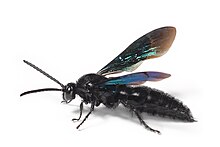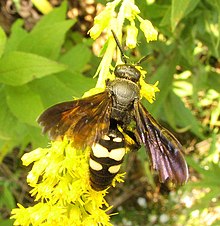Scoliidae
| Scoliidae | |
|---|---|

| |
| Black flower wasp (Austroscolia soror), Australia | |
| Scientific classification | |
| Kingdom: | Animalia |
| Phylum: | Arthropoda |
| Class: | Insecta |
| Order: | Hymenoptera |
| Infraorder: | Aculeata |
| Superfamily: | Scolioidea |
| Family: | Scoliidae Latreille, 1802 |
| Subfamilies | |
|
| |
The Scoliidae, the scoliid wasps, are a family of about 560 species found worldwide. They tend to be black, often marked with yellow or orange, and their wing tips are distinctively corrugated. Males are more slender and elongated than females, with significantly longer antennae, but the sexual dimorphism is not as apparent as in the Tiphiidae.
Biology[]
Scoliid wasps are solitary parasitoids of scarab beetle larvae. Female scoliids burrow into the ground in search of these larvae and then use their sting to paralyze them. They will sometimes excavate a chamber and move the paralyzed beetle larva into it before depositing an egg. Scoliid wasps act as important biocontrol agents, as many of the beetles they parasitize are pests, including the Japanese beetle. Male scoliids patrol territories, ready to mate with females emerging from the ground. Adult wasps may be minor pollinators of some plants and can be found on many wildflowers in the late summer.[citation needed]
Scoliidae also has at least one species known to engage in pseudocopulation with an orchid. Flowers of the orchid Bipinnula penicillata in subtropical South America resemble females of Pygodasis bistrimaculata, tricking male wasps into attempting to mate and, in the process, provide pollination.[1] Scoliids include some of the largest wasps in the world, such as Megascolia procer.[2]
Taxonomy[]
Scoliidae genera are classified as follows:[3][4][5]


Subfamily: []
- Rasnitsyn 1977 [6]
Subfamily: []
Tribe: Campsomerini[]
- Bradley 1957
- Betrem, 1972
- Betrem, 1962
- Campsomeriella Betrem, 1941
- Campsomeris Lepeletier, 1838
- Betrem, 1972
- Betrem, 1971
- Dufour, 1841
- Betrem, 1967
- Bradley, 1951
- Dasyscolia Bradley, 1951
- Dielis Saussure & Sichel, 1864
- Betrem, 1972
- Betrem, 1967
- Betrem, 1933
- Betrem, 1972
- Bradley, 1957
- Betrem, 1928
- Betrem, 1967
- Betrem, 1972
- Betrem, 1972
- Betrem, 1967
- Betrem, 1928
- Pygodasis Bradley, 1957
- Betrem, 1962
- Bradley, 1957
- Betrem, 1941
- Bradley, 1957
- Bradley, 1957
- Betrem, 1963
- Gribodo, 1893
- Betrem, 1967
- Betrem, 1972
- Betrem, 1972
- Xanthocampsomeris Bradley, 1957
Tribe: Scoliini[]
- Austroscolia Betrem, 1927
- Saussure & Sichel, 1864
- Betrem, 1928
- Guérin-Méneville, 1838
- Megascolia Betrem, 1928
- Betrem, 1928
- Bradley, 1959
- Bradley, 1957
- Scolia Fabricius 1775
- de Saussure 1863
North American species list[]
There are about 20 species in North America north of Mexico.[7] Species include:
- (Fabricius 1793) (introduced species, no established population)
- (Klug 1810) (introduced species, no established population)
- (Say 1823) – eight-spotted scoliid wasp
- (Viereck 1906)
- (Banks 1917) – Halcyon scoliid wasp
- (Bradley 1928)
- (Fabricius 1787) – Caribbean scoliid wasp
- (Saussure 1858) – hairy-footed scoliid wasp
- (Drury 1770) – feather-legged scoliid wasp
- (Saussure 1857) – Toltec scoliid wasp
- Dielis trifasciata (Fabricius 1793) – three-banded scoliid wasp
- (Say 1837) – saddleback scoliid wasp
- (Fabricus 1775) – large four-spotted scoliid wasp
- Scolia bicincta (Fabricius 1775) – double-banded scoliid wasp
- Scolia dubia (Say 1837) – two-spotted scoliid wasp, blue-winged scoliid wasp
- (Burmeister 1853)
- (Saussure 1858)
- Scolia nobilitata (Fabricius 1805) – noble scoliid wasp
- (Smith 1855) – fire-tailed scoliid wasp
- (Rohwer 1927)
- (Cresson 1865)
- (Rohwer 1921)
- (Burmeister 1853)
References[]
- ^ Ciotek, Liliana; Giorgis, Pablo; Benitez-Vieyra, Santiago; Cocucci, Andrea A. (2005). "First Confirmed Case of Pseudocopulation in Terrestrial Orchids of South America". Flora - Morphology, Distribution, Functional Ecology of Plants. 201 (5): 365–369. doi:10.1016/j.flora.2005.07.012.
- ^ Sarrazin, Michaël; Vigneron, Jean Pol; Welch, Victoria; Rassart, Marie (2008-11-05). "Nanomorphology of the blue iridescent wings of a giant tropical wasp Megascolia procer javanensis (Hymenoptera)". Physical Review E. 78 (5): 051902. arXiv:0710.2692. doi:10.1103/PhysRevE.78.051902.
- ^ Osten, T. (2005). "Checkliste der Dolchwespen der Welt (Insecta: Hymenoptera, Scoliidae). Teil 1: Proscoliinae und Scoliinae: Campsomerini. Teil 2: Scoliinae: Scoliini. Teil 3: Literatur" [Checklist of the Scoliidae of the World. Part 1: Proscoliinae and Scoliinae: Campsomerini. Part 2: Scoliinae: Scoliini. Part 3: Literature] (PDF). Bericht der Naturforschenden Gesellschaft Augsburg (in German). 62 (220–221): 1–62. Retrieved 2014-06-24.
- ^ "Classification and checklist of Afrotropical mammoth wasps". Retrieved 2019-07-18.
- ^ "BugGuide - Family Scoliidae". Retrieved 2019-07-18.
- ^ "Fauna Europaea".
- ^ Poole, R.W.; Gentili, P. "Hymenoptera" (PDF). Nomina Insecta: A Check List of the Insects of North America Nearctica. 2: 309–375. ISBN 1-889002-02-X. Retrieved 2011-10-10.
External links[]
| Wikimedia Commons has media related to Scoliidae. |
- Scoliidae
- Apocrita families
- Biological pest control wasps
- Insects used as insect pest control agents
